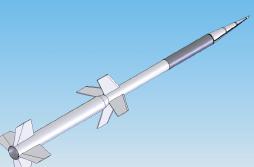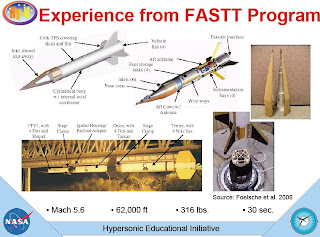The Air Force is eying the Mach-20 Falcon Hypersonic Test Vehicle as the basis for the new strike missile. “Our focus is on boost-glide capabilities, including the Hypersonic Technology Vehicle concept,” Maj. Gen. David Scott said this week. “We have no plans for conventionally armed sea-based missiles such as a [Navy] Conventional Trident modification or conventionally-armed ICBMs.”
The gliding missile has the extra advantage of fitting seamlessly into existing operations. The Pentagon hasn’t used non-nuclear ballistic missiles in many decades, but cruise-missile launches are routine. The only difference between an armed hypersonic glider and the Air Force’s existing Joint Air-to-Surface Standoff Missile would be range: A B-52 carrying armed gliders could fire the missiles thousands of miles from their targets and still take them out in just minutes’ time.
As a modest proof-of-concept, the Air Force successfully test-launched its much smaller and less speedy X-51 hypersonic cruise missile, pictured, from a B-52 in May last year.
US hypersonic program materials
2. 28 page presentation on the Hi-V (mach 5 hypersonic vehicle
Aerospace engineering researchers and students at the University of Virginia are helping to create a hypersonic “scramjet” engine that can travel at five times the speed of sound – or 3,700 mph. That’s about twice the speed of a bullet, and it’s technology that could one day allow a plane to fly from New York to Los Angeles in just 40 minutes.
The research team is preparing to unveil a prototype of the scramjet engine, along with a two-stage sounding rocket, on the front lawn of Thornton Hall, home to the U.Va. School of Engineering and Applied Science. The ceremony will take place Monday at 1 p.m.
Flight Experiment
• Terrier-Improved Orion (Mk 70 first stage)
• Inlet-combustor or inlet-combustor-nozzle
• Same scale scramjet at same conditions
If you liked this article, please give it a quick review on ycombinator or StumbleUpon. Thanks

Brian Wang is a Futurist Thought Leader and a popular Science blogger with 1 million readers per month. His blog Nextbigfuture.com is ranked #1 Science News Blog. It covers many disruptive technology and trends including Space, Robotics, Artificial Intelligence, Medicine, Anti-aging Biotechnology, and Nanotechnology.
Known for identifying cutting edge technologies, he is currently a Co-Founder of a startup and fundraiser for high potential early-stage companies. He is the Head of Research for Allocations for deep technology investments and an Angel Investor at Space Angels.
A frequent speaker at corporations, he has been a TEDx speaker, a Singularity University speaker and guest at numerous interviews for radio and podcasts. He is open to public speaking and advising engagements.





